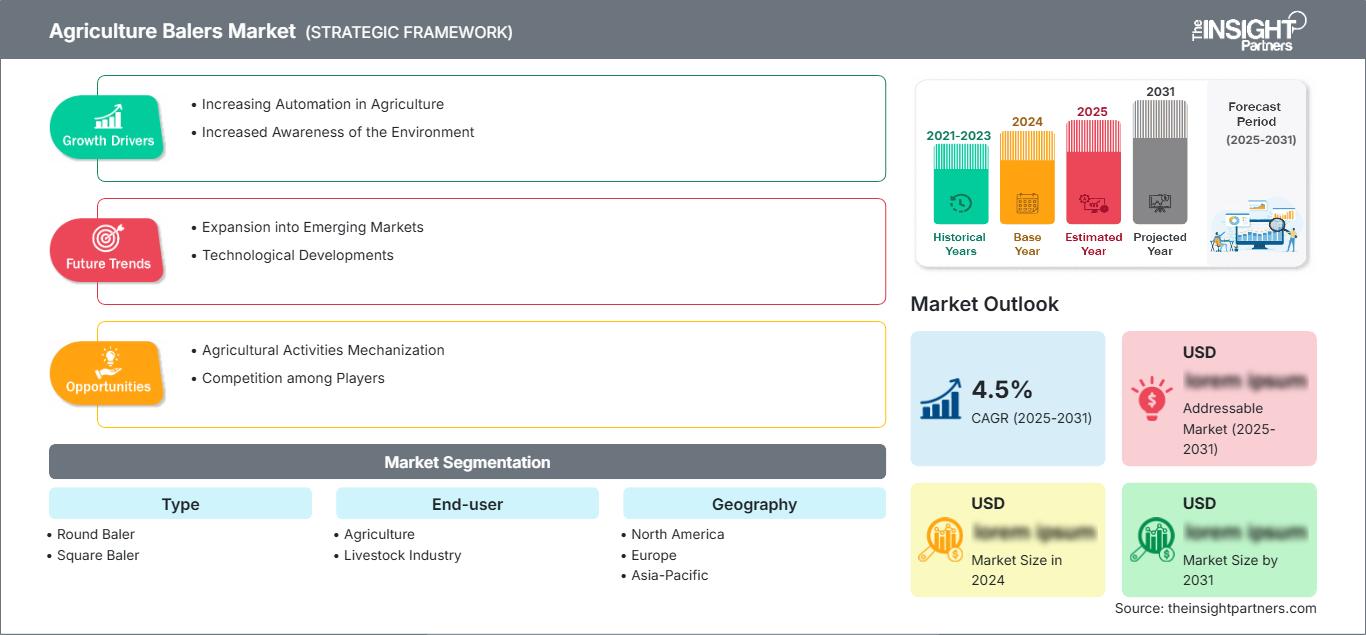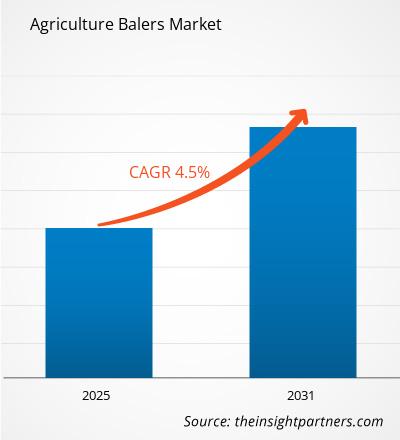Der Markt für landwirtschaftliche Ballenpressen wird voraussichtlich zwischen 2025 und 2031 eine durchschnittliche jährliche Wachstumsrate (CAGR) von 4,5 % verzeichnen, wobei die Marktgröße von XX Millionen US-Dollar im Jahr 2024 auf XX Millionen US-Dollar im Jahr 2031 anwachsen wird.
Der Bericht ist nach Typ (Rundballenpresse, Quaderballenpresse) und Endverbraucher (Landwirtschaft, Viehwirtschaft) segmentiert. Die globale Analyse ist weiter nach Regionen und wichtigen Ländern aufgeschlüsselt. Der Bericht bietet den Wert in USD für die obige Analyse und Segmentierung.
Zweck des Berichts
Der Bericht „Markt für landwirtschaftliche Ballenpressen“ von The Insight Partners zielt darauf ab, die aktuelle Situation und das zukünftige Wachstum sowie die wichtigsten treibenden Faktoren, Herausforderungen und Chancen zu beschreiben. Dies bietet verschiedenen Geschäftspartnern Einblicke, wie beispielsweise:
- Technologieanbieter/-hersteller: Um die sich entwickelnde Marktdynamik zu verstehen und die potenziellen Wachstumschancen zu kennen, damit sie fundierte strategische Entscheidungen treffen können.
- Investoren: Um eine umfassende Trendanalyse hinsichtlich der Marktwachstumsrate, der finanziellen Marktprognosen und der Chancen entlang der Wertschöpfungskette durchzuführen.
- Regulierungsbehörden: Um Richtlinien und Überwachungsaktivitäten auf dem Markt zu regulieren, mit dem Ziel, Missbrauch zu minimieren, das Vertrauen der Investoren zu wahren und die Integrität und Stabilität des Marktes aufrechtzuerhalten.
Marktsegmentierung für landwirtschaftliche Ballenpressen: Typ
- Rundballenpresse
- Quaderballenpresse
Endnutzer
- Landwirtschaft
- Viehzucht
Sie erhalten kostenlos Anpassungen an jedem Bericht, einschließlich Teilen dieses Berichts oder einer Analyse auf Länderebene, eines Excel-Datenpakets sowie tolle Angebote und Rabatte für Start-ups und Universitäten.
Markt für landwirtschaftliche Ballenpressen: Strategische Einblicke

- Holen Sie sich die wichtigsten Markttrends aus diesem Bericht.Dieses KOSTENLOSE Beispiel umfasst Datenanalysen, die von Markttrends bis hin zu Schätzungen und Prognosen reichen.
Wachstumstreiber für landwirtschaftliche Ballenpressen
- Zunehmende Automatisierung in der Landwirtschaft: Der Trend zur Automatisierung in der Landwirtschaft treibt die Nachfrage nach Ballenpressen stark an. Da Landwirte bestrebt sind, ihre Landwirtschaft effizienter und produktiver zu gestalten, sind automatisierte Ballenpressen zu einem der wichtigsten Instrumente in der modernen Landwirtschaft geworden.
- Steigerndes Umweltbewusstsein: Das Bewusstsein für Luftverschmutzung und nachhaltige Landwirtschaft treibt die Nachfrage nach landwirtschaftlichen Ballenpressen an. Ballenpressen gehören zu den Geräten, die bei der ordnungsgemäßen Handhabung von Ernterückständen helfen.
Zukünftige Trends auf dem Markt für landwirtschaftliche Ballenpressen
- Expansion in Schwellenmärkte: Die Marktexpansionsmöglichkeiten liegen größtenteils in den Schwellenmärkten des landwirtschaftlichen Wandels. Die Modernisierung der Landwirtschaft ist deutlich vorangekommen, und folglich besteht eine Nachfrage nach moderneren Ballenpressen. Daher haben Hersteller bei steigender Nachfrage gute Chancen.
- Technologische Entwicklungen: Dank verbesserter Effizienz und der Integration von Präzisionslandwirtschaftswerkzeugen ermöglichen fortschrittliche Entwicklungen in der Ballenpressentechnologie den Unternehmen eine Produktdifferenzierung. Landwirte werden voraussichtlich weitere Marktanteile gewinnen, da sie technologisch anspruchsvolle Produktivitätssteigerungen erwarten.
Marktchancen für landwirtschaftliche Ballenpressen
- Mechanisierung landwirtschaftlicher Tätigkeiten: Der zunehmende Trend zur Mechanisierung in der Landwirtschaft beeinflusst auch den Ballenpressenmarkt. Die Betonung mechanischer Lösungen für die meisten landwirtschaftlichen Praktiken wird die Nachfrage nach Ballenpressen im Zuge der Weiterentwicklung der Landwirtschaft weiter steigen lassen.
- Wettbewerb zwischen den Akteuren: Die zunehmende Produktinnovation und der Preiswettbewerb zwischen den Unternehmen werden voraussichtlich die Entwicklung des Marktes vorantreiben.
Markt für landwirtschaftliche Ballenpressen
Die Analysten von The Insight Partners haben die regionalen Trends und Faktoren, die den Markt für landwirtschaftliche Ballenpressen im Prognosezeitraum beeinflussen, ausführlich erläutert. In diesem Abschnitt werden auch die Marktsegmente und die geografische Lage landwirtschaftlicher Ballenpressen in Nordamerika, Europa, im asiatisch-pazifischen Raum, im Nahen Osten und Afrika sowie in Süd- und Mittelamerika erläutert.Umfang des Marktberichts für landwirtschaftliche Ballenpressen
| Berichtsattribut | Einzelheiten |
|---|---|
| Marktgröße in 2024 | US$ XX million |
| Marktgröße nach 2031 | US$ XX Million |
| Globale CAGR (2025 - 2031) | 4.5% |
| Historische Daten | 2021-2023 |
| Prognosezeitraum | 2025-2031 |
| Abgedeckte Segmente |
By Typ
|
| Abgedeckte Regionen und Länder | Nordamerika
|
| Marktführer und wichtige Unternehmensprofile |
|
Marktdichte von Ballenpressen für die Landwirtschaft: Auswirkungen auf die Geschäftsdynamik verstehen
Der Markt für landwirtschaftliche Ballenpressen wächst rasant. Dies wird durch die steigende Endverbrauchernachfrage aufgrund veränderter Verbraucherpräferenzen, technologischer Fortschritte und eines stärkeren Bewusstseins für die Produktvorteile vorangetrieben. Mit der steigenden Nachfrage erweitern Unternehmen ihr Angebot, entwickeln Innovationen, um den Bedürfnissen der Verbraucher gerecht zu werden, und nutzen neue Trends, was das Marktwachstum weiter ankurbelt.
- Holen Sie sich die Markt für landwirtschaftliche Ballenpressen Übersicht der wichtigsten Akteure
Wichtige Verkaufsargumente
- Umfassende Abdeckung: Der Bericht analysiert umfassend Produkte, Dienstleistungen, Typen und Endnutzer des Marktes für landwirtschaftliche Ballenpressen und bietet einen ganzheitlichen Überblick.
- Expertenanalyse: Der Bericht basiert auf dem umfassenden Verständnis von Branchenexperten und Analysten.
- Aktuelle Informationen: Der Bericht gewährleistet Geschäftsrelevanz durch die Berichterstattung über aktuelle Informationen und Datentrends.
- Anpassungsoptionen: Dieser Bericht kann an spezifische Kundenanforderungen angepasst werden und passt sich optimal an die Geschäftsstrategien an.
Der Forschungsbericht zum Markt für landwirtschaftliche Ballenpressen kann daher dazu beitragen, die Branchensituation und die Wachstumsaussichten zu entschlüsseln und zu verstehen. Obwohl es einige berechtigte Bedenken geben mag, überwiegen die Vorteile dieses Berichts tendenziell die Nachteile.
- Historische Analyse (2 Jahre), Basisjahr, Prognose (7 Jahre) mit CAGR
- PEST- und SWOT-Analyse
- Marktgröße Wert/Volumen – Global, Regional, Land
- Branchen- und Wettbewerbslandschaft
- Excel-Datensatz
Aktuelle Berichte
Erfahrungsberichte
Grund zum Kauf
- Fundierte Entscheidungsfindung
- Marktdynamik verstehen
- Wettbewerbsanalyse
- Kundeneinblicke
- Marktprognosen
- Risikominimierung
- Strategische Planung
- Investitionsbegründung
- Identifizierung neuer Märkte
- Verbesserung von Marketingstrategien
- Steigerung der Betriebseffizienz
- Anpassung an regulatorische Trends




















 Kostenlose Probe anfordern für - Markt für landwirtschaftliche Ballenpressen
Kostenlose Probe anfordern für - Markt für landwirtschaftliche Ballenpressen